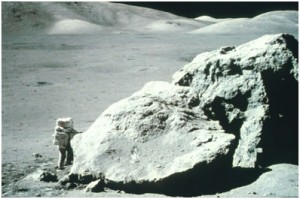
Fig. 1. One of the last two men on the Moon: Harrison Schmitt stands next to a large boulder at the Apollo 17 landing site in December 1972. (NASA).
Today, 19 December 2012, marks exactly 40 years to the day since the last human beings to set foot on the Moon, Gene Cernan and Harrison “Jack” Schmitt of Apollo 17 (Fig. 1), returned safely to Earth. In the three and a half years between Neil Armstrong’s ‘first small step’ in July 1969 and the departure of Cernan and Schmitt from the lunar surface in December 1972, a total of twelve astronauts explored the lunar surface in the immediate vicinity of six Apollo landing sites (Fig. 2).

Fig 2. The Apollo landing sites. Note their restriction to the central part of the nearside – there is a lot more of the Moon to explore! (Image: NASA).
In their cumulative 12.5 days on the lunar surface, the twelve Apollo moonwalkers traversed a total distance of 95.5 km from their landing sites (heavily weighted to the last three missions that were equipped with the Lunar Roving Vehicle (or ‘moon buggy’), collected 382 kg of rock and soil samples, drilled three geological sample cores to depths greater than 2 m, and deployed over 2100 kg of scientific equipment (Fig. 3). The results from all this activity continue to have a major scientific impact today.
Apollo science
Probably the greatest scientific legacy of Apollo has resulted from analysis of the 382 kg of rock and soil samples returned to Earth. One of the key results has been the calibration of the lunar cratering rate. Only by comparing the density of impact craters on surfaces whose ages have been obtained independently by laboratory analyses of returned samples is it possible to determine the rate at which meteorite impacts have created craters on a planetary surface. Analysis of the Apollo samples has enabled this to be done for the Moon, which remains the only planetary body for which such a data-set exists, and which is used, with various assumptions, to estimate the ages of cratered surfaces throughout the Solar System from Mercury to the moons of the outer planets.
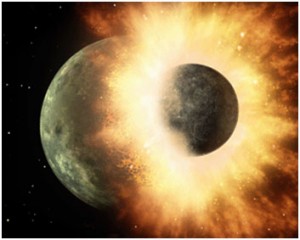
Fig. 5. The current theory of the Moon’s formation from debris produced by a giant impact on the early Earth is largely based on the geochemical analysis of samples collected by the Apollo missions (image: Wikipedia Commons).
Another important result of Apollo sample analysis has been the evidence provided for the origin of the Moon. In particular, the discovery that lunar materials have compositions broadly similar to those of Earth’s mantle, but that the Moon is highly depleted in volatiles and has only a small iron core, led to the current view that the Moon formed from debris resulting from a giant impact of a Mars-sized planetesimal with the early Earth. It is very doubtful that we would have sufficient geochemical evidence usefully to constrain theories of lunar origins without the quantity and diversity of samples provided by Apollo.
Birkbeck’s involvement
The Apollo samples have of course also been central to our understanding of the Moon’s own geological history and evolution. While lunar geology may at first sight appear to be a relatively parochial area of planetary science, it is important to realise that the Moon’s surface and interior retain records of planetary processes which will have occurred in the early histories of all the terrestrial planets. In all these respects the Moon acts as a keystone for understanding the geological evolution of rocky planets, and is an area in which we at Birkbeck are actively engaged (Fig. 6).

Fig. 6. Fragments of Apollo 12 soil sample 12023 at the Lunar Sample Laboratory at the NASA Johnson Space Center, Houston, being selected for a lunar volcanic diversity study by Birkbeck scientists in 2009. Inset (left to right): PhD student Joshua Snape (now a post-doc at the Open University), the author, and Dr Katherine Joy (now at the University of Manchester); since this photo was taken Birkbeck PhD student Louise Alexander has also joined the project (photo: I.A. Crawford).
Lunar geophysics
In addition to study of the Apollo samples, many other areas of scientific investigation were also performed by the Apollo missions, especially geophysical investigations of the Moon’s interior (Fig. 7). Key results included the discovery of natural moonquakes and using them to probe the structure of the crust and mantle, geophysical constraints on the existence and physical state of the lunar core, and measurements of the flow of heat from the Moon’s interior. Although these data are over thirty years old, advances in interpretation means that they continue to give new insights into the interior structure of the Moon. For example, only last year an apparently definitive seismic detection of the Moon’s core, and strong evidence that, like the Earth’s, it consists of solid inner and liquid outer layers, was made by a re-examination of Apollo seismic data.
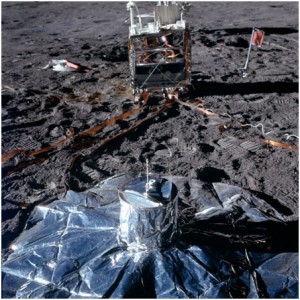
Fig. 7. Apollo 14 seismometer deployed on the lunar surface; the silvery skirt provided thermal stability. These instruments, also deployed at the Apollo 12, 15 and 16 landing sites, constituted the Apollo passive seismic network which remained active until 1978 and yielded valuable data about the interior of the Moon (NASA).
Looking over the totality of the Apollo legacy, I think one could reasonably make the case that Apollo laid the foundations for modern planetary science, certainly as it relates to the origin and evolution of the terrestrial planets. Arguably, the calibration of the lunar cratering rate, and its subsequent extrapolation to estimating surface ages throughout the Solar System, could alone justify this assertion. If one also considers the improvements to our knowledge of lunar origins and evolution, and the records of solar wind, cosmic rays and meteoritic debris extracted from lunar soils, it is clear that our knowledge of the Solar System would be greatly impoverished had the Apollo missions not taken place.
Time to go back?
However, it is also clear that Apollo did little more than scratch the surface, both literally and figuratively, of the lunar geological record. With only six landing sites, all at low latitudes on the nearside (Fig. 2), it is clear that much remains to be explored. Moreover, precisely because we have the Apollo legacy as a foundation on which to build, supplemented by recent orbital remote-sensing missions, it is now possible to formulate much more sophisticated lunar exploration strategies than was possible forty years ago. There are now key, specific, scientific questions which can only be addressed by once again returning to the lunar surface (Fig. 8).
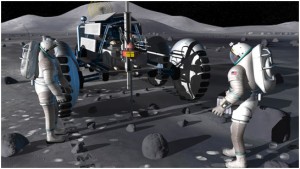
Fig. 8. Artist’s concept of astronauts supervising a drill on the Moon. Returning humans to the lunar surface later in the 21st century would facilitate larger scale exploration activities than was possible with Apollo, and will further increase our knowledge of lunar and Solar System evolution (artwork: NASA).
Therefore, as we pass the 40th anniversary of the last human expedition to the Moon, there are good scientific reasons to start planning for a return. However, unlike the Cold War competition that drove Apollo, a human return to the Moon in the coming decades would ideally be part of a sustained, international, programme of Solar System exploration such as the emerging Global Exploration Strategy.
Ian Crawford is Professor of Planetary Science and Astrobiology in the Department of Earth and Planetary Sciences, Birkbeck, University of London. His group is actively engaged in a number of areas of lunar science, and has recently been awarded a grant of £99,300 by STFC to study lunar meteorites found on Earth. This blog article is based on a popular article published in the December 2012 issue of the Royal Astronomical Society journal Astronomy and Geophysics, and a more technical review paper just published in Planetary and Space Science.

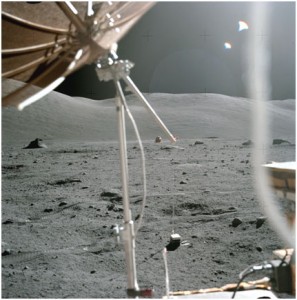
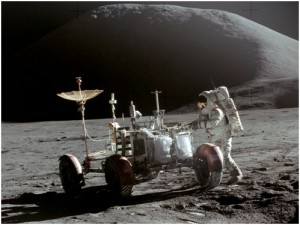
Pingback: Acho Aki » countryCountry Fried Steak